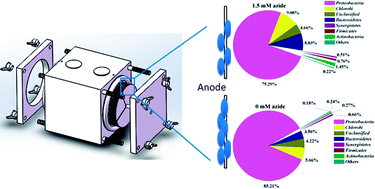Effects of azide on current generation and microbial community in air-cathode MFCs
Abstract
Azide is known to be a respiratory inhibitor, which can disrupt electron transfer in the process of aerobic respiration. It has been proposed for preventing the reduction of oxygen in the anode compartment of MFC-based biosensors, but has also been found to function as an electron acceptor in recent research. However, there are few reports about the effects of azide on the structure and composition of the microbial community in air-cathode MFCs, as well as on their corresponding performance. Therefore, the current generation, electroactivity and community structure of anodic biofilms were investigated using air-cathode MFCs acclimated with (1.5 mM) and without azide. The enrichment process was much slower in the presence of azide compared to the control. Biofilms enriched with and without azide were found to produce similar voltammograms, but the difference lay in the current intensity of the predominant peaks. Pyrosequencing indicated that the distribution of microbes at the genus level was more uniform, with Geobacter and Ignavibacterium being the dominant genera on both biofilms, although the community of the azide-enriched film was less diverse than that of the control. These results demonstrate that the microbial community enriched with azide was not significantly altered compared to the control and the difference in the maximum current or peak current of cyclic voltammograms (CVs) was thought to be related to the amount of biomass.


 Please wait while we load your content...
Please wait while we load your content...